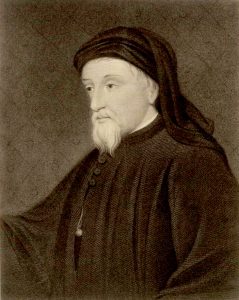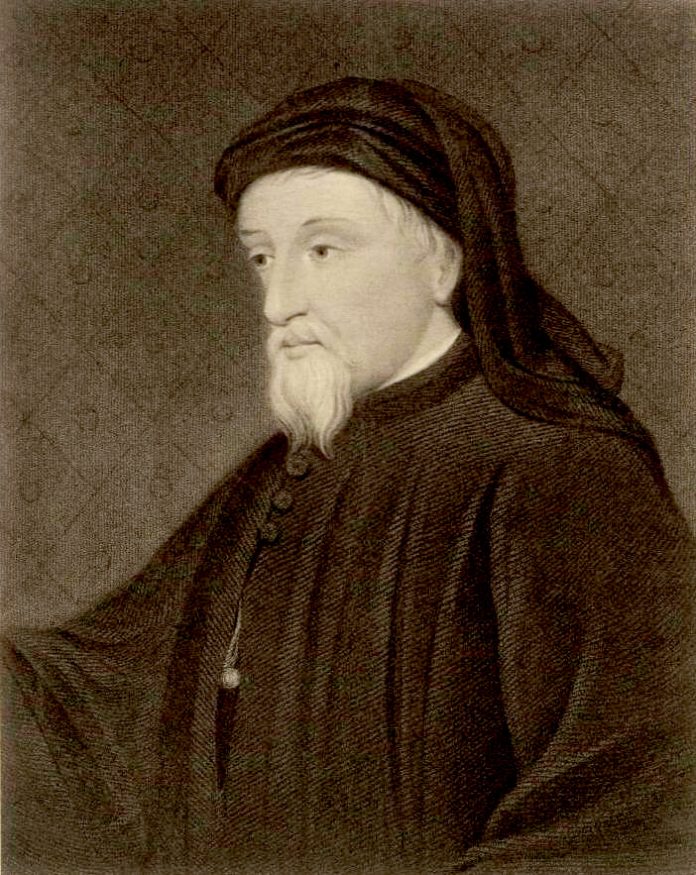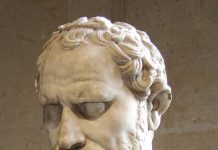The Archbishop of Seville, Isidore (560-636), established a telescoping set of units, beginning with the largest. He wrote “Our ancestors divided the world into parts. They put parts into provinces; provinces into regions; regions into districts; districts into territories, territories into fields, fields into centuries, centuries into acres, acres into zones, zones into actus, then rods, paces, steps, cubits, feet, palms, uncia and digits.” The last being the length of a human finger.
In this book about how space (not outer space, but the space of physical areas) was portrayed and understood in medieval England, Dr. Matthew Goldie of Rider University in New Jersey writes extensively about Geoffrey Chaucer (1340-1400). I was at Westminster Abbey for a commemoration of Chaucer on the 600th anniversary of his death in the year 2000.
One of the texts Goldie looks at is the Prioress’s Tale from Canterbury Tales, the most famous book from that era, completed at the end of Chaucer’s life. “It begins with a spatial telescoping effect,” Goldie writes, “common in Chaucer’s introductions to tales, in which the focus narrows from a large geographical area to a smaller and smaller location.” Where Chaucer derived the concept is not explored by Goldie, but it can certainly be traced back to Isidore, some 750 years earlier. (Goldie does not mention Isidore in the book).
The concept was certain widely understood, as it was also deployed by the monk and poet John Lydgate (1370-1451) in Siege of Thebes. There, says Goldie, “a large scene telescopes step by step into a smaller and smaller one until we end at a very specific location set within a delimited estre. Like other telescoping beginnings, such as the Prioress’s Tale, this one is also allegorical.” While place and space may connote different things now, “in Middle English, the words place and space are fairly synonymous.” Which brings us to the word estre, a noun from Middle English “to denote a defined area in the absence of the noun locality, which does not exist at the time.” It was used for example to denote individual cities, or merely different places within a garden.
“Literature differs from the local maps because literary works are much more invested in the implications of space not just for any objects but specifically for human identity, activity, and sociality.” This reflects the co-equal focus of the author’s book: he considers not only literary texts, but those based on scientific/mathematical work, such as maps. While artistically valuable, they don’t look ‘right’ to modern eyes. Goldie admits “it remains difficult to appreciate the older style of maps on their own terms because they do not reflect current practices and seem objectively incorrect.”
We learn that the first maps “that seem to render area in an abstracted manner is graticular, or grid, maps with meridian (longitude) and parallel (latitude) lines that begin to appear in the fourteenth century in Italy.” They offer us an insight into Medieval thought. “The gracticule maps are systematic and seem to demonstrate a thinking about the earth that sees its phenomena not so much according to the individuated characteristics but in terms of placement and relative location.” A related system derives from maps of constant scale which shows diverse “kinds or genres of objects drawn as approximately the same size.” Thus buildings both large and small are shown equally. “The earliest use of mathematical principles to create constant scale “ is found in maps of Vienna and Bratislava (now the capital of Slovakia) in 1421. “The contents are abstracted to become signs, and the viewer’s experience of space is of the entities on maps as forming a system.”
The prosaic discussion of constant scale and grid coordinates leads Goldie to some fascinating speculation. There are some texts in which “one glimpses a spatial overview” rather than the usual horizontal perspective. These exceptional moments can be motivated by spiritual, physical (such as climbing a mountain), or textual elevation. “One is tempted to think,” writes the author, “that the abstracting moments have similarities with developments in cartography” such as constant scale and grid coordinates. Goldie discerns a unique, if rarely encountered, sense of space in some medieval texts. “The contemplative life and the compendius propensities of late-medieval encyclopaedism afford understandings of space as an entity in itself with areas and phenomena that have roughly equal weight and significance.”
The text assumes a shared knowledge base the reader may not have. For example, the “Hereford map” is mentioned on page 83, with no explanation of what it is (made around the year 1300, it is the largest medieval map of the world still extant, and can be seen in Hereford Cathedral). The Index is fine, but not perfect. For example, Hipparchus, who appears on pg. 85, has no entry, and the telescoping idea similarly finds no place there. The book has a few B&W illustrations, but needs more: a discussion of graticules on maps is not accompanied by any visual examples. The concept of distortion in maps is mentioned, but an important paper in this regard, which discusses the Hereford map in detail, is not included in the 23 pages of references: Tobler (1966): Medieval Distortions: The Projections of Ancient Maps.
I have only touched on a few matters in this review of a book that is filled with deep insight on such critical topics as the nature of proximity, where the author applies scientific ideas about locality to Chaucer’s Legend of Good Women; and the concept of motion in another Chaucer book, the House of Fame, dating to about 1380. For those who have only read Canterbury Tales, this book will reveal Chaucer in a whole new light as a man of great learning, not just the greatest storyteller of the ages.
An impressive volume that deserves to be carefully studied by those interested in literary history, early science, physics, and ancient history as it is grounded in the works of both Aristotle and Ptolemy.
Scribes of Space: Place in Middle English Literature and Late Medieval Science ($55) is by Cornell University Press.














